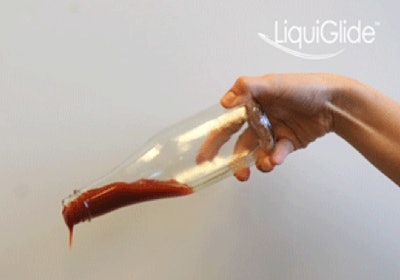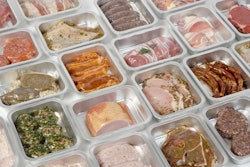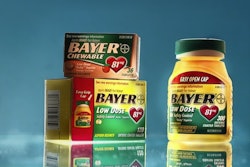Super-slick coatings have a range of industrial uses, but MIT researchers are targeting their new food-safe LiquiGlide material at a common consumer problem—getting the ketchup out of the bottle.
MIT mechanical engineers and nanotechnologists have teamed up to solve a common consumer problem that could soon have many processors and packagers upgrading their production lines. The problem: How do you get the ketchup out of the bottle? The solution, according to the researchers, is to first apply “LiquiGlide,” a patent-pending, food-safe substance that coats the inside of plastic or glass bottles to make them super slippery.
Imagine getting all the mayonnaise out of the jar, or every last drop of hot sauce out of the bottle. I see spontaneous Vine endorsements popping up for many innovation-driven food brands. But the technology doesn’t stop at the dinner table. Video demonstrations show the benefits of the coating for dispensing honey, cough syrup, wood glue, and paint. As it says on the LiquiGlide website, “be it the pouring of a ketchup bottle, creating efficiency gains on a power plant condenser or preventing a medical tube from clogging, LiquiGlide coatings are a breakthrough technology for solid-liquid interfaces.”
Working only with FDA-approved materials to create the substance, MIT PhD candidate Dave Smith and the team at MIT’s Varanasi Research Group created the unique material that he calls “kind of a structured liquid—it’s rigid like a solid, but it’s lubricated like a liquid.” The process does not involve nanotechnology, and the coatings can be created from all sorts of materials. Applying it to glass, metal, ceramic, or plastic bottles, tubes, or pipe allows for “an efficient and complete evacuation of liquids” from the vessels. Drops as small as 20 microns shed off a LiquiGlide-coated surface, Smith added.
The team has been working for years on a material that could be used for anti-icing airplane wings (ice behaves similarly to a viscous liquid) or preventing clogs in oil pipelines. In an interview with Fast Company magazine, Smith said, “Somehow this sparked the idea of putting it in food bottles. It could be great just for its slippery properties. Plus, most of these other applications have a much longer time to market; we realized we could make this coating for bottles that is pretty much ready. I mean, it is ready.”
The industrial applications are numerous. Putting LiquiGlide into processing lines could help prevent clogs, increase efficiency, and reduce cleaning and maintenance time. The substance could be applied to condensers in power plants and thereby improve efficiency by increasing the shedding of water droplets. Power lines or refrigeration units could be coated with the material to prevent ice build up.
As for foodstuffs, ketchup makers have been quick to try new ways to increase condiment accessibility and improve the customer experience (I’m thinking of Heinz wide-mouth jars and PET squeeze bottles, for example), but they are by no means the only ones. So when the first consumer products with LiquiGlide coatings come out in 2014, keep lots of napkins handy.



























